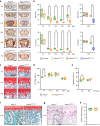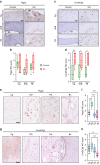Piezo1 expression in chondrocytes controls endochondral ossification and osteoarthritis development
- PMID: 38395992
- PMCID: PMC10891122
- DOI: 10.1038/s41413-024-00315-x
Piezo1 expression in chondrocytes controls endochondral ossification and osteoarthritis development
Abstract
Piezo proteins are mechanically activated ion channels, which are required for mechanosensing functions in a variety of cell types. While we and others have previously demonstrated that the expression of Piezo1 in osteoblast lineage cells is essential for bone-anabolic processes, there was only suggestive evidence indicating a role of Piezo1 and/or Piezo2 in cartilage. Here we addressed the question if and how chondrocyte expression of the mechanosensitive proteins Piezo1 or Piezo2 controls physiological endochondral ossification and pathological osteoarthritis (OA) development. Mice with chondrocyte-specific inactivation of Piezo1 (Piezo1Col2a1Cre), but not of Piezo2, developed a near absence of trabecular bone below the chondrogenic growth plate postnatally. Moreover, all Piezo1Col2a1Cre animals displayed multiple fractures of rib bones at 7 days of age, which were located close to the growth plates. While skeletal growth was only mildly affected in these mice, OA pathologies were markedly less pronounced compared to littermate controls at 60 weeks of age. Likewise, when OA was induced by anterior cruciate ligament transection, only the chondrocyte inactivation of Piezo1, not of Piezo2, resulted in attenuated articular cartilage degeneration. Importantly, osteophyte formation and maturation were also reduced in Piezo1Col2a1Cre mice. We further observed increased Piezo1 protein abundance in cartilaginous zones of human osteophytes. Finally, we identified Ptgs2 and Ccn2 as potentially relevant Piezo1 downstream genes in chondrocytes. Collectively, our data do not only demonstrate that Piezo1 is a critical regulator of physiological and pathological endochondral ossification processes, but also suggest that Piezo1 antagonists may be established as a novel approach to limit osteophyte formation in OA.
© 2024. The Author(s).
Conflict of interest statement
The authors declare no competing interests.
Figures









References
Publication types
MeSH terms
Substances
Grants and funding
LinkOut - more resources
Full Text Sources
Medical
Molecular Biology Databases
Research Materials
Miscellaneous

